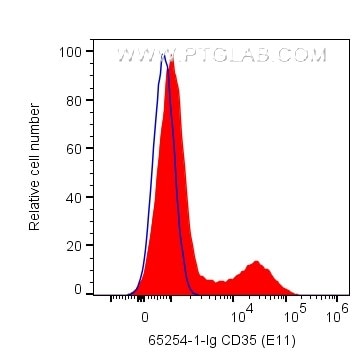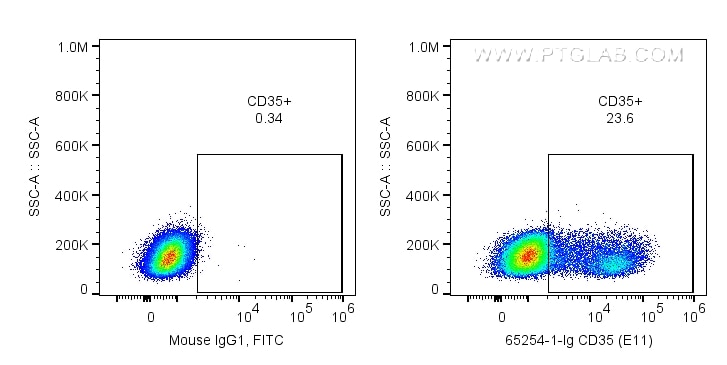CD35 Monoklonaler Antikörper
CD35 Monoklonal Antikörper für FC, ELISA
Wirt / Isotyp
Maus / IgG1, kappa
Getestete Reaktivität
human
Anwendung
FC, ELISA
Konjugation
Unkonjugiert
CloneNo.
E11
Kat-Nr. : 65254-1-Ig
Synonyme
Galerie der Validierungsdaten
Geprüfte Anwendungen
| Erfolgreiche Detektion in FC | humane PBMCs |
Empfohlene Verdünnung
| Anwendung | Verdünnung |
|---|---|
| This reagent has been tested for flow cytometric analysis. It is recommended that this reagent should be titrated in each testing system to obtain optimal results. | |
| Sample-dependent, check data in validation data gallery | |
Produktinformation
65254-1-Ig bindet in FC, ELISA CD35 und zeigt Reaktivität mit human
| Getestete Reaktivität | human |
| Wirt / Isotyp | Maus / IgG1, kappa |
| Klonalität | Monoklonal |
| Typ | Antikörper |
| Immunogen | Human CD35 from Acute monocytic leukemia cells and normal blood monocytes |
| Vollständiger Name | complement component (3b/4b) receptor 1 (Knops blood group) |
| Berechnetes Molekulargewicht | 224 kDa |
| GenBank-Zugangsnummer | NM_000573 |
| Gene symbol | CR1 |
| Gene ID (NCBI) | 1378 |
| Konjugation | Unkonjugiert |
| Form | Liquid |
| Reinigungsmethode | Affinitätsreinigung |
| Lagerungspuffer | PBS with 0.09% sodium azide. |
| Lagerungsbedingungen | Store at 2-8°C. Stable for one year after shipment. |
Hintergrundinformationen
CD35, also known as complement receptor type 1 (CR1) or C3b/C4b receptor, is a single-chain glycoprotein consisting of 30 repeating homologous protein domains known as short consensus repeats (~60 amino acids each) followed by transmembrane and cytoplasmic domains (PMID: 8765013). CD35 is variably expressed by granulocytes, monocytes, B cells, some T cells, erythrocytes, follicular dendritic cells, Langerhans cells, and glomerular podocytes (PMID: 19004497). CD35 acts as a receptor for C3b and C4b and plays important roles in the regulation of the complement cascade and clearance of immune complexes.
Protokolle
| Produktspezifische Protokolle | |
|---|---|
| FC protocol for CD35 antibody 65254-1-Ig | Protokoll herunterladen |
| Standard-Protokolle | |
|---|---|
| Klicken Sie hier, um unsere Standardprotokolle anzuzeigen |



